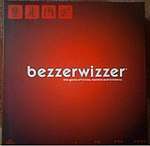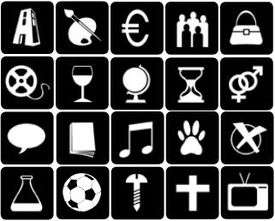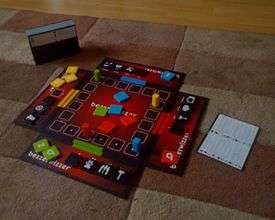Bezzerwizzer
Bezzerwizzer is a trivia game combining trivia and tactics. The game was invented in 2006 by the Dane Jesper Bülow. The name "Bezzerwizzer" comes from the originally German term "Besserwisser", meaning "know-it-all".
| the game of trivia, tactics and trickery. | |
|---|---|
 Cover Image | |
| Manufacturer(s) | Mattel, Bezzerwizzer ApS |
| Designer(s) | Jesper Bülow |
| Years active | 2006–present |
| Players | 2–4 teams |
| Setup time | 5 minutes |
| Playing time | 45 minutes |
| Random chance | Low – Moderate (Question Categories) |
| Age range | Aimed at 15+ |
| Skill(s) required | General knowledge, tactics |
| Website | http://www.bezzerwizzer.co.uk/ |
Mattel has released versions for the United Kingdom, France, Germany, and the United States.
In Denmark there are three different editions of Bezzerwizzer, developed by the Danish company Bezzerwizzer ApS. Until now, Bezzerwizzer ApS has sold more than 100,000 Bezzerwizzer games in Denmark. Bezzerwizzer ApS has also launched the game in Finland, Norway, Sweden, the Netherlands and Belgium. In Spain, the company Falomir Juegos released the Spanish version in 2016.
Gameplay

Question types
The questions are divided into 20 different categories, each built upon different topics (in alphabetical order):
- Architecture (Buildings, Architects and Designers)
- Art & Stage (Artists, Painters, Sculptors, Theatre and Opera)
- Business World (Companies, Business People, Products, Trademarks and Advertisements)
- Communities (Legislation, Education, Labour market, Institutions and Associations)
- Design (Fashion, Furniture, Interiors, Household design, Logos and Symbols)
- Film (Titles, Actors, Directors and Roles)
- Food & Drink (Gastronomy, Wine, Beer, International Cuisine and Ingredients)
- Geography (Countries, Cities, Oceans and Seas)
- History (Historical persons, Places and Events)
- Humans (Physiology, Anatomy, Psychology, Medicine and Lifestyles)
- Language (Foreign languages, Foreign words, Idioms and Sayings)
- Literature (Titles, Authors, Philosophers and Literary Characters)
- Music (Artists, Composers, Titles and Concepts)
- Nature (Animals, Plants, Nature and The Environment)
- Politics (Politicians, Parties, Organisations and Forms of Government)
- Science (Physics, Chemistry, Mathematics and Astronomy)
- Sports & Games (Athletes, Sports, Games and Records)
- Technology (Technology, Space Travel, Computers, Crafts and Tools)
- Tradition & Beliefs (Religion, Mythology, Traditions, Customs and Habits)
- TV & Radio (Programmes, News, People and Media Stories)
Setup
Players are split up into teams, most of the time playing separately. Each team selects a playing piece and takes two Bezzerwizzer tiles (denoted by the letter b) and one Zwap (denoted by the letter z) tile of the same color.
Each team then draws four category tiles (see picture above) at random from the bag, and places them on their tile board in order of preference. Each question has a point value determined by the number of dots above it. For example, a team may pick the tiles Music, Film, Food and Politics. If they are confident at getting a question in one subject right they would put it on the fourth square on the board (scoring four points for a correct answer). There is no obvious varying difficulty between questions. Tiles cannot swap positions after being put down.
The team that plays first is chosen randomly by picking one playing piece from the bag – the owner of the playing piece goes first, though going first has no real advantage.
Play

For every point scored a team moves forward one square.
Play goes in a clockwise direction from the team who plays first. The team will be asked their one-point question first based on the topic they put on their board. The team answers the question and score the corresponding number of points if they answer correctly. An incorrect answer has no penalty. During their team's turn a team may use their Zwap tile. This allows this team to swap any two tiles (once those questions haven't been asked in that round). They may swap two tiles between any two teams or swap the two tiles of the same team (including their own) to produce a different order. Teams may play one tile during a round.
After all questions have been asked once – this will be 16 questions if four teams are playing – the round ends. The game continues as normal after four category tiles are picked again.
Endgame
The first team to reach the finish is the winner, unless another team also reaches the finish in the same round. If two or more teams finish in the same round, then sudden death occurs. For each sudden-death round, each team draws one category tile from the bag and gets a single question on that. Teams remain in sudden death for every round that they answer correctly or when all teams answer that round of questions incorrectly. The last team remaining in sudden death is declared the winner.
If a team is situated on the home stretch (within the last five squares of the board), another team may force them to go backwards. The attacking team does this by playing a Bezzerwizzer tile. If the attacking team answers the question correctly and the defending team does not, it may choose to move the defending team's piece backwards (the same number of points) instead of moving their own forward.
